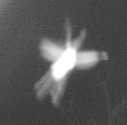
Could this be a long-eared bat? The proportions do not seem right. Does anyone know, please?
Taken in Dordogne last night.
Martha

Could this be a long-eared bat? The proportions do not seem right. Does anyone know, please?
Taken in Dordogne last night.
Martha
Thank you, Brian!
This creature is certainly always in the lavender. Its body reflects as much as animals' eyes. I have hunted though many more photos and attached are two more. One (again above a stone marten) reflecting intensely, the other with a vaguely moth shape. Both are in the lavender.
It's a mystery but thank you again, and many thanks to your friend as well.
Martha
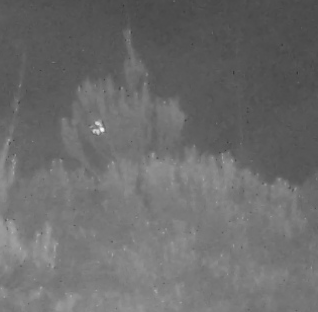
Martha, my friend has left me a message saying that long eared bats are almost certainly hibernating. Because they spend the three to four months in hibernation between November and February and will have mated before going into their hibernacula that are mainly underground, they tend not to appear until spring when the pregnancy will begin properly once feeding conditions are optimal. Ovulation and fertilisation is delayed for weeks or months and thus the pregnancy does not commence until a couple of days after after waking from hibernation and feeding to rebuild energy.
However, once having mated they need to go into suspended animation, the females cluster in large groups to keep the entire mass insulated, the males do the same in their own group. It is unusual for individuals to leave the colony at that stage but not entirely unknown if, for instance, a bat dislocates, falls and flies out into the open where it is warm enough although at least at 4°C or lower they lose so much body temperature that their wings soon cease to function and they are then normally doomed to die of hypothermia.
Wow, we live to learn and it is never too late.
Anyway, he thinks the proportions are wrong, it would appear to have too much body bulk but too little wing membrane and as far as he can make out above the stone marten entirely the wrong size. He ruled out any kind of owl because again the shape and proportions are totally wrong and the positions in flight very unlikely to be like that. What he suggests is that there are quite a few very large varieties of moths that are only nocturnal and may be a large Acherontia or Hawk moth that can be nearly the size of a smallish human hand, feed on lavender and rosemary especially, a few flowers of which are present all year round plus tiny deposits of pollen remain in dried flowers. They also do not hibernate because their life span is too short to allow that. With the antennae and tail appearing at least to be the right proportion and a typical hovering position he suggests that.
I would never have even considered a moth since I thought they were finished bar the ones who find our lights in winter months. For me the mystery remains open!
I am very much a lover of hunting birds, the barn owl being my favourite of all birds. The bats are 'kind of' through having had a colony in my roof in the UK and finding out more, plus Jean-Pi who will no doubt get back to me later today is an orchid lover like me but knows mammals best of all from his training though and if he thinks it is a bat he'll say straight off, but this a tough one with those shots.
An owl would be very cool! Thank you so much for e-mailing your friend.
I have never actually seen the creature. I leave a motion-triggered camera outside at night and this is what it caught.
Thank you again for helping.
Martha
The megascops owls have brow feathers that are often described as either ears or horns in their common names. The white front would say owl to me. The bats are about three times as wide wing tip to wing tip, as long from top head to bottom of body, the legs are joined to the wing membranes and make the bat appear far more triangular with the ears sticking out making up the length to almost equal wing span. The wing span is well under 5cm and the end of legs to tip of ears a little less. The other clue would be if there are caves or tunnels nearby where long eared bats hibernate rather than buildings, they apparently use thermal warmth from the ground to not freeze.
Then again there are the otus family of owls, the common scops owl is a bit over 15cm body length and has the 'horns' in flight would look that shape.
I'll email the local expert who knows pretty well most fauna and flora species in the department (he was a professional in that world for the department for many years) to ask his opinion. The chances are we are both (er hem) stabbing in the dark ;-)
Thank you for the map. I am not so far from one. There are plenty of empty buildings around where bats could be anyway. I do not think it is an owl, as there are those objects like ears or antennae on the head. Here is the full photo, with too much flash, showing it above a stone marten, to give a better idea of the size. And a second photo of it zooming in front of lavender. It must have a very white front to get that flare. And a third photo shows a bit more of the body shape.
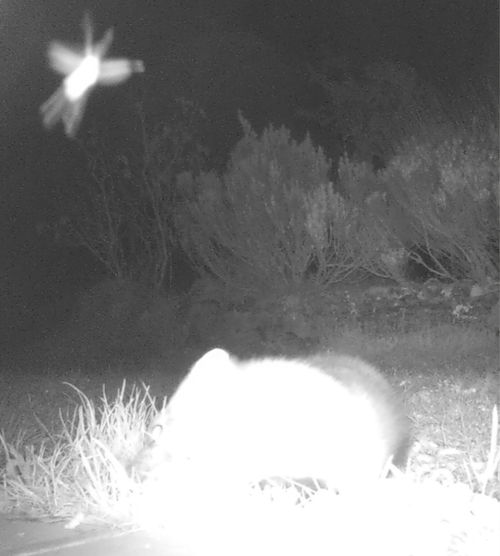
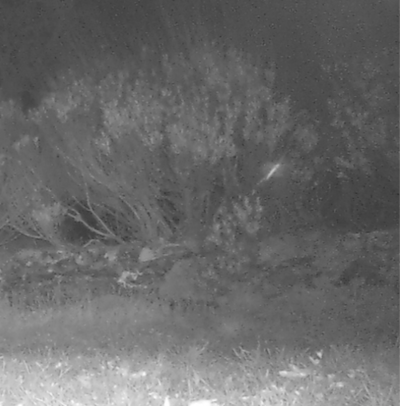
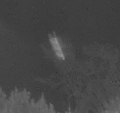
Martha
Perhaps. Look at this map of Aquitaine to see if you are near or at (vaguely, such is the map) one of the colony areas: www.gca-asso.fr/wp-content/uploads/2012/02/Oreillards.pdf
The shot is vague, allowing for the flaring I might think it is actually a screech owl (megascops ...) a couple of types of are very small and at height may look tiny. As you say, the proportions in as far as they can be made out, look wrong. Long eared bats are really very small and flit about quite jerkily, also should be hibernating by now although our colony of pipistrelles has been awake and out feeding the last two nights. Anyway, think about the flight pattern and was it straight or a slightly jerky one. If straight then the owl for sure.